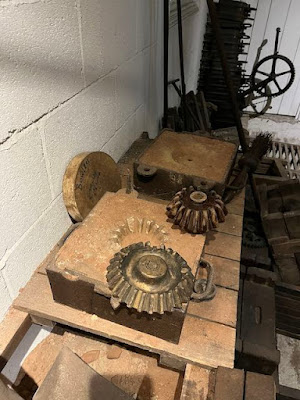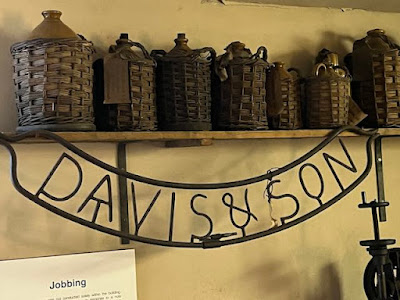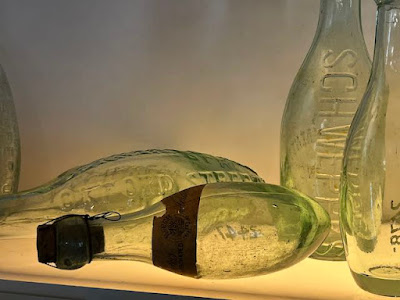Since the Bath at Work Museum was unexpectedly closed the previous day when we tried to visit, we made one more attempt on our last day (knowing we had to leave at noon to get Delaney back in time for a class). This museum was Delaney's pick so I didn't know what to expect. It was smallish, but really cool! Just enough there to spending an hour or so.
The collection is basically all the remaining inventory, parts, equipment from a company that was owned and operated for three generations in Bath. The founder was JP Bowers. They had 13 children, nearly all of whom went into the business. It was started in the late 1800's and finally closed in 1969. The contents were incorporated into a museum in 1978.
The original location was elsewhere in Bath, but the museum building was acquired and all the rooms were basically recreated like a time capsule in the new location. The business started with small metal works, mostly brass, but expanded to include a very successful carbonated drink division in the early 1900s.
The family prided itself on economizing and the collection included the one and only machine that they bought new. All the rest of the equipment was bought second hand, or custom built by employees for the company. This typewriter was from the front office.
I particularly liked this Coleman-like gas lamp with a second 'spout' below it that could be used for melting sealing wax (or lighting the owners pipe).
In the pattern shop, the craftsman would make wooden models of the metal parts to be cast. These had to be slightly bigger than the needed piece because the metal would shrink as it cooled.
The metal (brass or other alloys) would be heated in the forge and then poured into sand molds that were made from the wooden models. These cooled and were finished by hand or with foot powered machinery.
It was a little overwhelming to see how many items they had in stock. My interpretation was that rather than being on the leading edge of change, the business was lagging. If you had an old item that needed a replacement part, this was the place to come. Eventually, even those old items were no longer in use and their supplies were not needed.
So of the finished brass pieces were coated in lacquer for the final step. For example, these handles for the beer on tap in pubs.
I found this sign fascinating. It was a predecessor to a neon sign. The letters were hollow with several holes in them. Gas would flow through them and a flame would be lit from each of the holes, thus making the metal letters stand out with the backlit flames.
In the early 1900's the technology developed to create CO2 gas and infuse it in water for carbonated drinks. Manufacturers started adding sugar and syrup flavors. This machine was used to create and store the CO2 using sulphuric acid and calcium carbonate.
This was the Essence room, where the secret recipe for the soda was kept and mixed. During WWII, the soda manufacturers were controlled by the Ministry of Food and were restricted to making particular flavors of drinks. Bower was allowed to make lemonade and cherryade.
In order to promote return of the glass bottles for re-use, the company would offer glass marbles to children who would bring in bottles. These glass marbles were part of the sealing mechanism for the bottles. They were made in the bottles and when the bottles were filled with carbonated water, the fizz pressure would press them up to the opening of the bottle and seal it.
There are over 10,000 glass bottles of various sizes and shapes in the collection. This is just a small portion of them.
All the wooden crates were branded with the company name.
Bottle with a cork and wire seal.
Bottle with an early rubber cork screw seal
Eventual best design: crown twist top
A trip to Bath would not be complete without getting some Bath Buns. Apparently what makes these special are the cube of sugar baked inside each one (tasty!) The time they are first mentioned historically is in a Jane Austin book.



























No comments:
Post a Comment